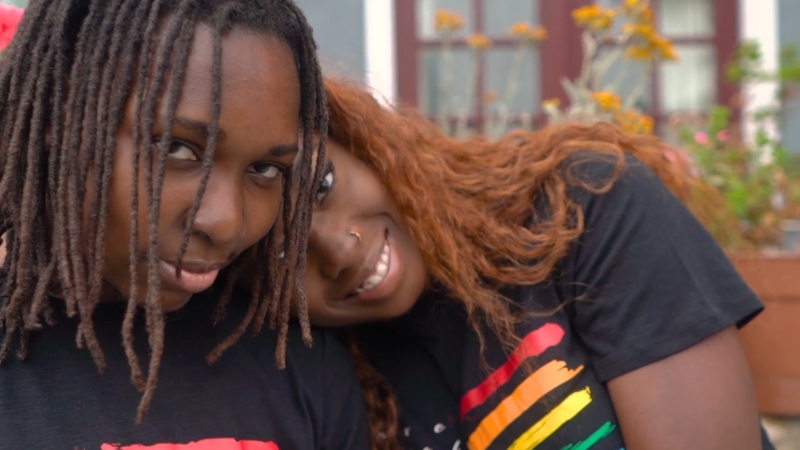Not all people who aren’t women are the same. The words transmasculine and nonbinary describe different gender experiences, and while there’s sometimes overlap, they’re not interchangeable.
If you’re confused, curious, or trying to use language that reflects the people around you, you’re not alone.
The thing is, gender vocabulary has grown and shifted, partly because the old boxes didn’t cut it.
And while the internet can be a goldmine of info, it’s also a maze of half-explained labels and Reddit threads that just… spiral.
So, let’s talk clearly and like real people. What’s the difference between someone who’s transmasculine and someone who’s nonbinary?
Can you be both? And how do you not accidentally lump people together who are saying very different things about who they are?
Let’s sort that out.
Transmasculine
Nonbinary
Refers to a gender experience that leans masculine
Refers to any identity not strictly male/female
Often used by people assigned female at birth
Can be used by people of any assigned sex
May or may not identify as a man
May or may not relate to masculinity/femininity
Focused on a masculine direction of identity
Focused on not fitting into binary categories
Can overlap with “nonbinary”
Can overlap with “transmasculine”
What Does “Transmasculine” Mean?
Someone who’s transmasculine leans toward masculinity in how they experience or express their gender, but they weren’t assigned male at birth.
That phrase “assigned male/female at birth” (often abbreviated AFAB or AMAB) shows up a lot in conversations around gender. It refers to what someone was labeled based on their physical anatomy, usually by a doctor, right after they were born.
For someone who’s transmasculine, that label was typically female, but their internal sense of self doesn’t align with that. Instead, they connect more with masculinity.
A Few Ways that Might Show Up
What ties it all together is a general move toward masculinity. It doesn’t mean someone’s aiming to be a stereotypical “dude.” It just means their gender leans in that direction.
So Then, What Is “Nonbinary”?
View this post on Instagram
Nonbinary is a bit broader. It’s an umbrella term for any gender identity that isn’t only male or only female.
If someone says they’re nonbinary, they’re usually saying: “Neither of the two standard options (man or woman) fully fits me.” That’s it. It doesn’t automatically tell you if they feel more feminine, more masculine, somewhere in between, or totally outside that spectrum.
Some Examples of Nonbinary Identities Include
- Agender (no gender at all)
- Bigender (two genders, which could shift or coexist)
- Genderfluid (a gender that shifts over time)
- Androgynous (blending masculine and feminine traits)
- Neutrois (a neutral or null-gender identity)
And others just say “nonbinary” without any sub-label. That’s valid, too.
Where It Gets Confusing (and Interesting): The Overlap
Here’s where people often start asking, “Wait, can someone be both nonbinary and transmasculine?” And the answer is—absolutely.
Gender isn’t a clean set of boxes. Some people sit at intersections. Someone could say:
“I’m nonbinary, but I lean masculine, and I use he/they pronouns.”
That person might feel aligned with masculinity—maybe in how they dress, speak, or interact socially, but still not feel like a man.
So they use transmasculine as a way to show that masculine lean, and nonbinary to show they’re not simply male.
Another person might say:
“I’m a trans guy. I used to identify as nonbinary, but over time I realized ‘man’ feels more accurate for me now.”
That’s also valid. Gender isn’t static. For a lot of people, it shifts—or clarifies—with time, new language, or life experiences.
Some Real-World Scenarios

Scenario 1: Jamie
Jamie is AFAB and uses he/they pronouns. They don’t feel like a man, but they dress in a traditionally masculine way and take low-dose testosterone. They tell people, “I’m nonbinary and transmasc.”
What’s going on here?
Jamie feels some alignment with masculinity, but not enough to identify fully as a man. They’re communicating that with both labels. That combo signals a nuanced identity: not binary, but not totally neutral either.
Scenario 2: Luca
Luca identifies as a trans man. He’s had top surgery and goes by he/him exclusively. He used to call himself nonbinary, but now says, “I’m just a guy.”
What’s going on here?
Luca’s identity evolved. That shift is common, and doesn’t mean he “wasn’t nonbinary enough” before. He’s just found a label that feels right now.
Scenario 3: Ari
Ari says, “I’m nonbinary. I don’t relate to masculinity or femininity, and I don’t like being called transmasc because it feels too gendered.”
What’s going on here?
Ari is nonbinary, but not transmasculine. That helps highlight that not all nonbinary people want to be read as masculine, or have anything to do with that side of the spectrum.
Why It Matters to Get It Right
@mx.gialu So I don’t have to? #nonbinary #transmasc ♬ original sound – Gialu
Language shapes perception. When you mislabel someone, like calling a nonbinary person “female-to-male” because they present masculine, it can be alienating. Even if it’s unintentional.
Being thoughtful with gender terms shows you’re listening. It says: You get to define who you are, not me.
Here are some respectful ways to engage:
- Ask for pronouns and preferred labels if you’re unsure. It’s not awkward; it’s respectful.
- Don’t assume transmasculine = man. Masculinity shows up in lots of ways, and not all of them lead to “guy.”
- Remember that nonbinary isn’t one look. There’s no “nonbinary outfit” or vibe. It’s an internal identity, not a style.
Let’s Start with Pronouns
What’s the Deal with People Using “he/they” or “she/they”? Which One Do You Use?
It’s not a trick question. If someone uses two (or more) pronouns, like he/they, it usually means they’re okay with either one. But preferences can vary.
What you can say:
“Hey, you use he/they—do you have a preference for one over the other?”
Simple. Respectful. Gets straight to the point.
If they say, “Nope, either is cool,” then great—you’ve got the green light to mix it up. If they say, “I mostly go by ‘they,’ but I don’t mind ‘he,’” then you know what to prioritize.
What if You Mess Up?
It’s okay. It happens. Correct yourself, apologize briefly, and move on.
No big dramatic apology, no long explanation about how hard you’re trying. Something like:
“She—sorry, they—were telling me about it yesterday.”
That’s it. Keep it moving.
Asking About Transitioning: What’s Off-Limits?

Short answer: don’t ask about someone’s body unless you’re close, they’ve brought it up, or it’s actually relevant (like if you’re their doctor).
Being curious is human. But just because someone’s transmasculine doesn’t mean you’re automatically invited to ask about surgeries, hormones, or their medical history.
Instead, focus on what they’ve chosen to share. Some people are really open and might talk about starting T (testosterone), getting top surgery, or changing their name. Others won’t—and that’s fine.
Better Ways to Ask, if The Topic Comes up Naturally
Keep the tone casual. Leave space for a number. And always make it about them deciding what to share, not you getting all the details.
When You’re Just Trying to Learn
There’s nothing wrong with wanting to know more about gender. But don’t treat the nearest transmasculine or nonbinary person like your walking Wikipedia.
If you’re in conversation and genuinely want to learn more, try this:
“I’ve been trying to learn more about gender identities—do you have any blogs or accounts you like?”
“I’m realizing how much I didn’t grow up knowing about this stuff. If there’s anything you feel like explaining, I’d love to learn.”
That way, you’re showing interest without pressure.
Good Resources to Explore on Your Own
Maia Kobabe’s ‘Gender Queer’ tops list of most criticized library books for third straight year https://t.co/TAXnnqBdTK
— The Associated Press (@AP) April 8, 2024
- Instagram & TikTok creators like @alokay, @seedingsovereignty, @urdoingreat
- Books like Gender Queer by Maia Kobabe or Life Isn’t Binary by Meg-John Barker & Alex Iantaffi
- YouTube channels like Ash Hardell or Ty Turner (great for hormone/top surgery Q&As from people who’ve lived it)
Questions That Are Totally Fine (and Not Weird)
You’re not interrogating; you’re just being present and supportive.
And Finally, Don’t Be Weird About the Timeline
Some people know their gender identity at six years old. Others figure it out at 26, 46, or never put a label on it at all.
No one’s “late.” No one’s “just going through a phase.” And not everyone wants to change their name or presentation overnight—or at all.
If you’re watching someone explore this in real time, just ride with them.
Try saying:
“Whatever pace you move at, I’ve got you.”
Because the best thing you can offer isn’t perfect knowledge—it’s consistency.
Common Myths (and What’s Actually True)

Myth #1: All transmasculine people are transitioning to become men
Not true. Some are. Others are simply moving toward a gender presentation that feels more masculine to them, but that doesn’t always mean becoming a man.
Myth #2: Nonbinary people are androgynous or neutral in every way
Nope. Some are, but others lean femme, masc, or both. Nonbinary just means not solely male or female.
Myth #3: You can’t be nonbinary and also use gendered pronouns
False. Pronouns aren’t gender identities. Plenty of nonbinary people use she/her or he/him because that feels right to them.
How to Support People Across the Spectrum
You don’t need a gender studies degree to show respect. You just need to be willing to listen and adjust.
Here’s what helps:
- Use the words people use for themselves. Not the ones that seem more convenient or familiar to you.
- Avoid pressuring people to explain everything. Ask what they’re open to sharing.
- Don’t assume change = confusion. Gender can evolve. That doesn’t mean someone doesn’t know who they are.
So… Transmasculine or Nonbinary?

Sometimes it’s one. Sometimes it’s both. Sometimes, someone you thought fit one label now fits another—and that’s okay.
The real question is less “which category are you?” and more “what’s the language that feels good to you right now?”
Final Thoughts
If you’re trying to be a better friend, partner, teacher, or even just a better internet user, it’s worth slowing down and listening to the way people name themselves.
Not every transmasc person is a man. Not every nonbinary person rejects masculinity. And nobody owes anyone a clean definition that fits neatly into a quiz result or dropdown menu.

